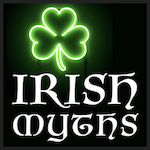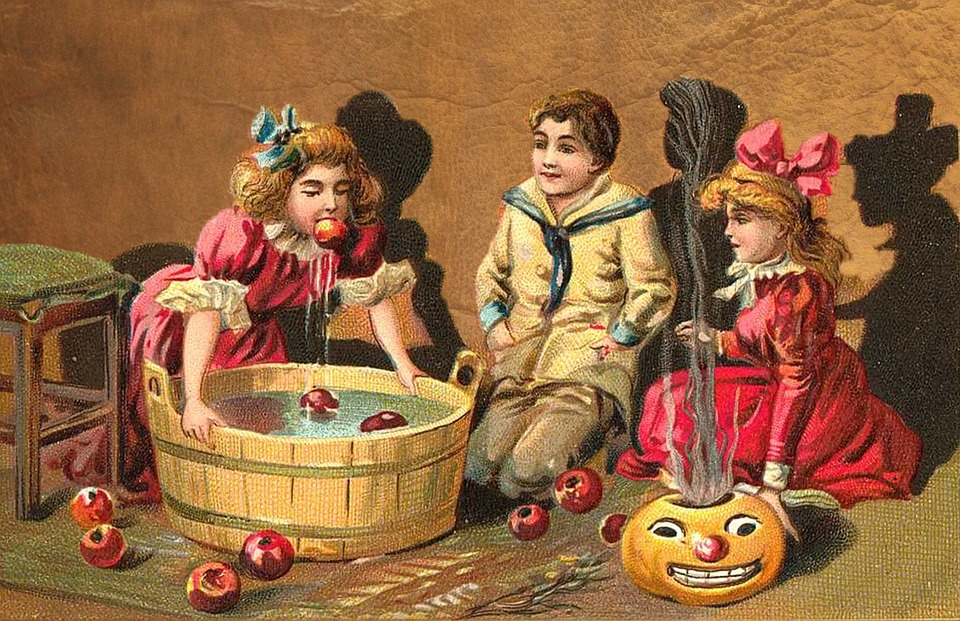Irish Myths is reader-supported. When you buy through links on our site, we may earn a small affiliate commission.
Nothing says “Halloween fun” quite like plunging your face into a bucket of water in the hopes of getting an apple wedged between your teeth like you’re some kind of prized pig preparing yourself for a roast.
I mean, seriously…where in the Tech Duinn did this bizarre, semi-aquatic autumnal custom come from?
Pssst. I made a video segment that answers this question if you’re more of an audio-visual learner. (Text continues below.)
Go back a couple of centuries, and you might have witnessed courtly lords and ladies bobbing for apples in an effort to foretell their romantic futures.
In Britain, a common version of the game was to have each floating apple correspond to a potential mate. Young women would take turns aiming their chompers at the apples named for the young men they fancied.
Get the apple on the first try, and the relationship was bound to blossom.
Get it on the second try, and sparks would fly at first but then the relationship would fizzle.
Get it on the third try, and the poor young lady might as well spit it out — the relationship just wasn’t meant to be.
What’s the Difference Between Snap Apple and Bobbing for Apples?
In Ireland, “snap apple” was (and still is, I believe) more popular than apple bobbing. This variation of the game typically sees players lunging teeth-first at apples suspended from strings rather than having them thrashing around in buckets of water.
In his 18th-century work Collectanea de Rebus Hibernicis, the British military surveyor Charles Vallancey (who was stationed in Ireland for much of his career) gave a play-by-play of a game of Irish snap apple, noting that young unmarried people would compete to determine who would be the next to marry. The first to sink their teeth into a dangling apple would be walking down the aisle in no-time.

The Celtic Origins of Snap Apple and Apple Bobbing
Clearly, bobbing for apples and snap apple both originated as courtship rituals — games for divining the future romantic entanglements of the players.
But what does that have to do with Halloween, or its predecessor, Samhain?
I’ll let journalist Alison Richards explain:
The specific connection between apples, fortune-telling and Halloween goes back to the Celtic festival Samhain. It fell around the end of our modern October, and marked the end of summer, the end of harvest and — revelers worried — perhaps the extinction of life itself. To encourage the sun deity to return the following year, ancient Celts burned huge bonfires into the night and tied apples to evergreen branches…
According to this tradition, barriers to the Underworld were temporarily suspended… It was a time when divination was supposedly especially powerful.
source: “The Secret, Steamy History Of Halloween Apples” (NPR)
So there you have it: apples hanging from tree branches, fortune-telling abilities believed to be at full-strength — the ingredients were there for a tradition like apple bobbing to develop.
It should also be mentioned that apples have a special place in Irish mythology. For example, the sea-god Manannán Mac Lir is said to rule a paradisiacal island called Emain Ablach (“Emain of the apple trees’), where apple trees bear fruit and blossoms simultaneously. What’s more, the voyage of the famed Irish hero Bran—who perhaps helped inspire the Game of Thrones character of the same name—begins with a mysterious woman giving him a silver branch with a white blossom from one of Emain Ablach’s trees.
The story of Emain Ablach would go on to influence another apple-filled island paradise: Avalon, from Arthurian legend. In Welsh, Avalon is called Ynys Afallach (“lsle of Afallach”). The Welsh word for apple is afall.
But enough about apples. Everyone knows the *real* symbol of Halloween is the pumpkin… right?
Editor’s note: this article is an excerpt from “The Celtic History Behind Our Favorite Halloween Traditions: 6 Samhain Rituals That Refuse to Die.
Want to learn the full story of Samhain? Check out…
Samhain in Your Pocket
Perhaps the most important holiday on the ancient Celtic calendar, Samhain marks the end of summer and the beginning of a new pastoral year. It is a liminal time—a time when the forces of light and darkness, warmth and cold, growth and blight, are in conflict. A time when the barrier between the land of the living and the land of the dead is at its thinnest. A time when all manner of spirits and demons are wont to cross over from the Celtic Otherworld. Learn more…
Want to learn about the darker side of Irish mythology? Check out…
Irish Monsters in Your Pocket
In the Ireland of myth and legend, “spooky season” is every season. Spirits roam the countryside, hovering above the bogs. Werewolves lope through forests under full moons. Dragons lurk beneath the waves. Granted, there’s no denying that Samhain (Halloween’s Celtic predecessor) tends to bring out some of the island’s biggest, baddest monsters. Prepare yourself for (educational) encounters with Irish cryptids, demons, ghouls, goblins, and other supernatural beings. Learn more…
Neon Druid: An Anthology of Urban Celtic Fantasy
“A thrilling romp through pubs, mythology, and alleyways. NEON DRUID is such a fun, pulpy anthology of stories that embody Celtic fantasy and myth,” (Pyles of Books). Cross over into a world where the mischievous gods, goddesses, monsters, and heroes of Celtic mythology live among us, intermingling with unsuspecting mortals and stirring up mayhem in cities and towns on both sides of the Atlantic, from Limerick and Edinburgh to Montreal and Boston. Learn more…
More the listenin’ type?
I recommend the audiobook Celtic Mythology: Tales of Gods, Goddesses, and Heroes by Philip Freeman (narrated by Gerard Doyle). Use my link to get 3 free months of Audible Premium Plus and you can listen to the full 7.5-hour audiobook for free.


So interesting! I didn’t know any of this. It’s been a minute since I’ve bobbed for apples, but I used to be pretty good at it 😉
LikeLike
Interesting indeed! Do you think perhaps another factor for the apples and divination connection might come from a match-making game? Given that festivals were also a time for match-making couples (although I imagine this is more true for Lughnasadh), that this could have come from a game which allowed young people to start relationships, possibly even non-committed fun ones that only lasted until Imbolc. Basically a bit like mistletoe and kissing at Christmas?
LikeLike